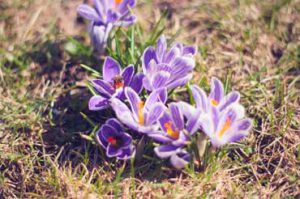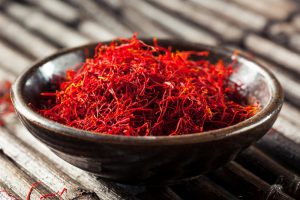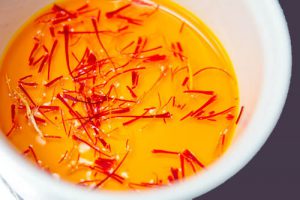What is saffron?
Iranian saffron is one of the world’s most expensive spices. Iran produces more than 93 percent of the world’s saffron, the world’s first saffron producer. The history of saffron planting in Iran dates back more than 3,000 years ago. Experts say saffron has grown for the first time in Greece, Iran, Turkey, and Afghanistan. According to historical documents, Iran saffron reflects on the fact that Iranians have been very interested in saffron from ancient times, celebrations such as weddings and festivals.
Crocus sativus saffron is a perennial herb that has a spherical bulb covered with a brown membrane. This plant grows in the regions of the Middle East, Southwest Asia, southern Spain, and southern Europe. Saffron has stems and six leaves of violets and three strands of red tulip, which is the commercial saffron. More than 100,000 to 200,000 saffron flowers are needed to produce a kilogram of saffron, and most of the saffron planting and harvesting steps are carried out manually, which also causes saffron, also called red gold.

Original Iranian saffron
How to check original saffron? All of these important features are found in the original saffron. The amount of coloration and the full purity of the saffron is measured in the laboratory. Some methods can identify the original saffron of its counterfeit type. There are a few key ways to tell real saffron from fake: aroma, form, and color.
Saffron aroma
The definitive way to recognize real Iranian saffron is its aroma. For this solution, you must know the smell of the original saffron. The real Saffron Aroma is a blend of tobacco, vanilla, honey. Certainly, If the saffron is fresh, it will smell more aroma.
Saffron form
The appearance of saffron is one of the ways to identify it purely. The appearance of this product is similar to clove. So that the bottom of the barrel and its ends are toothed, flattened and scissors.
Saffron color
The real Iranian saffron has a slower coloring speed. Only the real saffron will keep its original color when you take the thread out of the water. The original saffron color in the water is honey yellow, of course, clear. You pour a little saffron in water, wait up to 5 minutes. So, If they are white in the 5 minutes so the saffron is fake.
Best and easy ways to identify the original saffron from fake
Take a little saffron on a stove and flush the city gas methane. If the color changes to violet or orange, be happy that you have the original saffron. The fake saffron turns yellow. Also, real saffron is immiscible in gasoline, and if you pour a little of it into gasoline, its color should not change. Like other herbs and spices, Saffron is sensitive to light and Pour it into a glass container because if saffron storage conditions are not appropriate saffron oil will evaporate. The inappropriate container may reduce the Medicinal effects of saffron.
What does saffron taste like?
One of the most important ways to recognize the real Iranian saffron is its taste. Saffron never tastes sweet. Occasionally, people who are profitable to increase the weight of saffron, impregnate it with honey or sugar. As a result, the real saffron will have a bitter and slightly astringent taste. 
Iranian saffron types
Saffron types are not classified in the division, the place of production or the packaging company, or the variety of cultivating saffron, and this applies only to the red and yellow sections of saffron.
Negin saffron
is one of the best Iranian export saffron. Today, due to its high quality, high coloring power, and excellent smell is one of the most popular Iranian saffron. Most European countries are looking for Negin saffron. Negin saffron is saffron that is completely red and there is no white color. Its color strength is between 230 and 270.
Sargol saffron
Sargol saffron is completely reddish and cut-off saffron, in which there is no root. The coloring power is between 210 and 260.
Pushal saffron
Compared to various types of saffron, such as Sargol, pushal has some yellowing and a higher percentage of this product is red colored.
Saffron benefits
Today saffron solves many problems, including reducing fat and cholesterol, relaxing, appetite, antispasmodic, preventing heart disease and cancer, enhancing memory and learning, reducing blood pressure, treating Asthma, treatment of skin diseases, urinary tract infection, jaundice, menstruation, abdominal distension, anesthetic, and abdominal treatment. Also, Saffron has medicinal properties, and its most important feature is its joy that it is considered a drug against depression and is used as a natural and herbal treatment for nerves.
In recent studies in the United States, it has been shown that crossing in saffron in the spinal cord has had a positive and significant effect on blood pressure. Other studies have shown that saffron increases plasma oxygen levels and has anti-cancer effects. Research has shown that saffron can reduce triglycerides and cholesterol. Studies in Spain have also shown that reducing heart disease in part of this region is probably due to the constant consumption of saffron.
Since saffron is one of the most expensive spices, we definitely need to learn how to keep it. Due to the fact that the saffron oil can be evaporated, its medicinal properties and its quality will be reduced if stored in an open environment. Saffron must be kept in a container that is impervious to air (preferably a glass container) and kept in a cool, dry place away from light and moisture. The ideal temperature for storing saffron below 20 ° C and humidity is less than 40%.

Saffron side effect
Eating saffron at high doses can have potential risks because the high accumulation of highly active elements in saffron can have a range of effects on the body. In the consumption of drugs, the authorized amount is not more than 1 g. Eating more than 3 grams of saffron causes severe bleeding, abortion and sometimes death. Of course, in the world, there are reports of 5 to 9 grams of saffron that have been followed by deaths. However, there are no specific side effects or allergic characteristics in lower doses (for example, in meals or in supplementary pills). Some of the side effects reported include dry mouth, dizziness, nausea, anxiety, fatigue, and changes in appetite and taste, but these are very rare symptoms.
Where to buy Iranian saffron?
Iranian saffron has this unique feature compared to other saffron in the world market. The main factor determining the saffron price is the type and quality of saffron. Also, Determining the Iranian saffron price depends on the type, quality, packaging of the saffron, as well as the agreement between the seller and the buyer. In Iran’s export saffron, there is a very low amount of safranal in comparison with other saffron in the world market. Some saffron producers add some essential oils (most important of which are safranal) for saffron flavoring. While safranal in Iran’s export saffron, sometimes only up to 1% in saffron. As a result, Iranian saffron has the highest quality compared to other saffron.
Our company, Sunexport provides original Iranian saffron at the earliest time. We believe that our customers deserve the best service from us. The quality of export saffron of Iran is evidence of the high quality of the company’s products For more information, please contact us.
